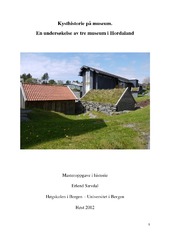| dc.contributor.author | Sævdal, Erlend | eng |
| dc.date.accessioned | 2013-02-13T08:33:15Z | |
| dc.date.available | 2013-02-13T08:33:15Z | |
| dc.date.issued | 2012-11-20 | eng |
| dc.date.submitted | 2012-11-20 | eng |
| dc.identifier.uri | https://hdl.handle.net/1956/6320 | |
| dc.description.abstract | Denne masteroppgaven er en analyse av tre museum i Hordaland og deres fremstilling av kysthistorien: Sunnhordland Museum, Hordamuseet og Kystmuseet i Øygarden. Utgangspunktet er at denne delen av norsk historie, av enkelte fremstilt som Norges kanskje mest særegne bidrag til den europeiske felleskulturen, i noen tilfelle ikke synes å være mer enn "en fotnote i den nasjonale historieskrivingen". Oppgaven inneholder først et innledningskapittel med gjennomgang av sentral litteratur og teori omkring museer. Deretter følger et kapittel for hvert av museene, med presentasjon og analyse av utstillingene ved museene. I siste kapitlet samles trådene ved en sammenligning av museene og en avsluttende konklusjon. Oppgaven har en tredelt problemstilling. Første del går på bakgrunnen for hvert av museene, og hvordan de plasserer seg i den norske museumstradisjonen. Særlig det såkalte folke-museumsparadigmet er her viktig. På dette punktet er konklusjonen at alle museene i større eller mindre grad, til tross alle samfunnsendringer og kritikk av dette paradigmet, fremdeles er påvirket av denne måten å tenke museum på. Andre del av problemstillingen er en analysen av aktuelle kysthistoriske temaer. Generelt er kysthistorien, særlig fra 1970-tallet, blitt mer vektlagt enn tidligere. Det synes å være flere grunner til en slik utvikling, blant annet økende profesjonalisering ved museene og kritikk mot den til da rådende historieformidlingen. I dag er således kysthistorien blitt et satsnings-område ved alle museene. Temaene er delt inn i to hovedområder, (1) økonomisk-tekniske tema og (2) sosiale, kulturelle og politiske sider ved kysthistorien. Gjennomgangen viser at museene vektlegger disse temaene forskjellig, spesielt kjønn samt de sosiale, kulturelle og politiske temaene har ulik prioritering ved museene. Noen av temaene er bra dekket, andre mer mangelfullt, og noen nesten helt fraværende. Tredje del av problemstillingen går på hvordan det blir formidlet gjennom utstillinger og undervisningsopplegg. Sentralt her står bruk av ulike utstillingsformer og fortellingsbegrepet, med en endring fra den store, nasjonale fortellingen til en fortellingsstruktur som inneholder mange mindre fortellinger. Dette viser seg også i formidlingen av kysthistorien ved de tre analyserte museene. | en_US |
| dc.description.abstract | Coastal History at the museum. A survey of three museums in the county of Hordaland, Norway. This Master thesis is an analysis of three museums in Hordaland and their representation of coastal history: Sunnhordland Museum, Hordamuseet and the Coastal Museum in Øygarden. The starting point is that this part of Norwegian history, by some described as Norway's perhaps most distinctive contribution to European culture, in some cases does not appear to be more than "a footnote in the national historiography". The thesis contains an introductory chapter with an overview of key literature and theory concerning museums. Then follows a chapter for each of the three museums in question, and a presentation and analysis of the exhibitions at these museums. In the last chapter the museums are compared and this chapter also contains a final conclusion. The task presents a threefold research question. The first part is the background for each of the museums and how they position themselves in the Norwegian museum tradition. In particular, the so-called folk museum paradigm is important. At this point, the conclusion that all the museums to a greater or lesser degree, despite all the changes in society and criticism of this paradigm, is still influenced by this way of thinking. The second part of the overall research question is an analysis of the relevant coastal historical themes. In general, coastal history, especially from the 1970s, has attracted more research interest than earlier. There seems to be several reasons for this trend, including increased professionalization of museums and criticism of the prevailing dissemination of research findings. Today's coastal history has thus become a priority area at all the three museums. The topics are divided into two main areas: (1) economic/technical topics and (2) social, cultural and political aspects of coastal history. The review shows that museums emphasize these issues differently, especially when it comes to gender related issues and social, cultural and political themes. Some of the topics are well covered, others less so, and some are almost completely absent. Third part of the research problem is centered on how one chooses to present all this. A crucial aspect here is the use of various forms and narrative concepts, with a change from the general, national narrative to a narrative structure that contains many local and regional stories. This is also reflected in the distribution of coastal history at the three museums which have been analyzed. | en_US |
| dc.format.extent | 6383519 bytes | eng |
| dc.format.mimetype | application/pdf | eng |
| dc.language.iso | nob | eng |
| dc.publisher | The University of Bergen | eng |
| dc.title | Kysthistorie på museum. En undersøkelse av tre museum i Hordaland | eng |
| dc.type | Master thesis | |
| dc.rights.holder | Copyright the author. All rights reserved | |
| dc.description.degree | Master i Historie | |
| dc.description.localcode | MAHF-HIS | |
| dc.description.localcode | HIS350 | |
| dc.subject.nus | 713107 | eng |
| fs.subjectcode | HIS350 | |
